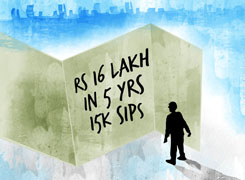Should I Continue Investing in My Current ELSS Funds?
Ramalingam Kalirajan |10881 Answers |Ask -Follow
Mutual Funds, Financial Planning Expert - Answered on Sep 16, 2024
He has an MBA in finance from the University of Madras and is a certified financial planner.
He is the director and chief financial planner at Holistic Investment, a Chennai-based firm that offers financial planning and wealth management advice.... more

Sir, I am investing in certain ELSS funds like Bandhan, Mirae Asset, DSP and Canara Robecco for the past three years. The lock in period is now over. I have received returns ranging from 38% to 58% in these funds. Should I continue investing in the same, or transfer this to other categories like Small caps, mid caps etc.
However, before taking any action, it’s essential to assess both your financial goals and the overall market situation. Since ELSS funds are equity-linked, they tend to offer high returns in the long run. But it's important to align your investment choices with your financial needs and risk appetite.
Continue in ELSS or Switch?
Let’s break down the factors to help you decide whether to continue investing in these ELSS funds or shift to other categories such as small-cap or mid-cap funds.
Performance Consistency: The ELSS funds you’ve mentioned have given strong returns, but consistency is key. Look at their long-term track record, not just the last three years. Consider whether they have consistently outperformed their benchmarks over the past 5-10 years.
Tax Benefits of ELSS: One of the primary reasons for choosing ELSS is the tax-saving benefit under Section 80C. Since your ELSS funds are no longer locked in, you are free to withdraw or shift funds. However, if you still need tax-saving instruments, continuing with ELSS might be wise.
Your Risk Appetite: ELSS funds are generally less risky compared to small-cap and mid-cap funds. If your risk tolerance is low, you might want to stay invested in ELSS funds. On the other hand, if you're looking for aggressive growth and are comfortable with more volatility, small-cap or mid-cap funds might suit you.
Investment Horizon: If your investment horizon is long-term (10 years or more), then investing in small-cap or mid-cap funds could yield higher returns. These categories are known for their potential to generate substantial growth, but they also come with higher risk.
Assessing Small-Cap and Mid-Cap Funds
Potential for Higher Returns: Small-cap and mid-cap funds tend to outperform large-cap and diversified funds over the long term. They invest in smaller and growing companies, which have the potential for higher growth.
Increased Volatility: The small-cap and mid-cap segments are also more volatile. They can experience sharp fluctuations based on market conditions, so you need to be prepared for potential short-term losses.
Diversification Benefit: If you are currently heavily invested in large-cap or diversified equity funds, adding small-cap and mid-cap funds can offer diversification. It’s important to have a well-balanced portfolio to spread risk across different segments.
Regular Review of Portfolio: Shifting to small-cap and mid-cap funds will require you to review your portfolio regularly. These funds are more sensitive to market conditions, and you will need to assess their performance more frequently compared to large-cap funds or ELSS.
The Role of Asset Allocation
Before making any changes to your investment, revisit your asset allocation strategy. The key to long-term financial success is ensuring that your portfolio is diversified across different asset classes. Here are some tips:
Equity Exposure: Since equity is known for long-term wealth creation, ensure that your portfolio has sufficient exposure to equity. If your risk tolerance is high, increasing exposure to small-cap and mid-cap funds might make sense.
Debt Exposure: If you have already allocated a significant portion of your portfolio to equity (including ELSS), you might want to balance it with some low-risk debt instruments like PPF, FDs, or bonds. This will reduce the overall risk and provide more stability.
Rebalance Regularly: Regular rebalancing is necessary to maintain your desired asset allocation. If one part of your portfolio grows faster than others, it might lead to overexposure to that asset class. Ensure you review your portfolio at least once a year.
Disadvantages of Direct Funds
If you are currently investing directly in these funds, it's important to understand that direct plans require you to manage everything on your own. Here are some downsides:
Lack of Professional Guidance: Direct funds don’t offer the expert advice and monitoring that come with regular funds through a certified financial planner. This can make it difficult for you to track performance and make timely decisions.
Time-Consuming: Managing direct funds requires significant time and effort. If you’re busy with your profession or other commitments, this might not be ideal for you.
Missed Opportunities: Without professional guidance, you may miss opportunities to rebalance or switch to better-performing funds at the right time.
It’s advisable to invest through a Certified Financial Planner (CFP), who can help you make informed decisions based on your risk profile, goals, and current financial situation.
Advantages of Regular Funds with a Certified Financial Planner
Professional Management: A CFP can help you choose the right funds and monitor your portfolio regularly, ensuring that it stays aligned with your financial goals.
Timely Advice: When markets are volatile, having professional advice is invaluable. They can guide you on when to stay invested or when to move your investments to other categories.
Goal-Oriented Approach: A CFP will keep your long-term financial goals in mind while recommending changes to your portfolio, ensuring that your investments remain focused on achieving your desired outcomes.
Evaluating Fund Categories
Since you are considering a switch to small-cap or mid-cap funds, here’s a quick evaluation of different fund categories:
Large-Cap Funds: These funds invest in large, established companies. They offer stability and moderate growth. If you want less volatility, consider large-cap funds.
Mid-Cap Funds: Mid-cap funds invest in medium-sized companies that have high growth potential. They offer higher returns than large-cap funds but are also more volatile.
Small-Cap Funds: These funds invest in smaller companies that are still in the growth phase. They offer the highest potential for returns but are also the most volatile.
Multi-Cap Funds: These funds invest across all categories – large, mid, and small-cap companies. They offer a balanced approach, combining stability with growth potential.
Best Practices for Future Investments
Continue SIPs: SIPs are a disciplined way to invest in equity markets. They allow you to average out your cost of investment and reduce the risk of market timing.
Focus on Long-Term Goals: If you have long-term financial goals such as retirement, education for your child, or wealth creation, keep your focus on building a strong portfolio with a long-term perspective.
Risk Management: Ensure that your portfolio is diversified enough to manage risk effectively. Don’t put all your money into one asset class or fund category.
Seek Professional Guidance: A CFP can help you review your existing portfolio and make any necessary changes based on your financial goals and risk tolerance. Regular reviews with a professional can ensure that you stay on track.
Final Insights
You have already built a strong investment base, which is commendable. Your ELSS funds have performed well, and you’re considering moving into more aggressive categories. However, before making any moves, consider your long-term goals, risk tolerance, and asset allocation strategy.
Shifting into small-cap or mid-cap funds could boost your returns, but they come with higher risk. Consult with a Certified Financial Planner to ensure that your portfolio is well-diversified and aligned with your financial objectives.
Best Regards,
K. Ramalingam, MBA, CFP,
Chief Financial Planner,
www.holisticinvestment.in
You may like to see similar questions and answers below
Omkeshwar Singh | Answer |Ask -Follow
Head, Rank MF - Answered on Jan 17, 2020
Ramalingam Kalirajan |10881 Answers |Ask -Follow
Mutual Funds, Financial Planning Expert - Answered on May 10, 2024
Ramalingam Kalirajan |10881 Answers |Ask -Follow
Mutual Funds, Financial Planning Expert - Answered on Jul 31, 2024
Ramalingam Kalirajan |10881 Answers |Ask -Follow
Mutual Funds, Financial Planning Expert - Answered on May 24, 2025
Ramalingam Kalirajan |10881 Answers |Ask -Follow
Mutual Funds, Financial Planning Expert - Answered on Jul 11, 2025
Nayagam P P |10854 Answers |Ask -Follow
Career Counsellor - Answered on Dec 14, 2025
Radheshyam Zanwar |6744 Answers |Ask -Follow
MHT-CET, IIT-JEE, NEET-UG Expert - Answered on Dec 14, 2025
Radheshyam Zanwar |6744 Answers |Ask -Follow
MHT-CET, IIT-JEE, NEET-UG Expert - Answered on Dec 14, 2025
Dr Dipankar Dutta |1840 Answers |Ask -Follow
Tech Careers and Skill Development Expert - Answered on Dec 14, 2025
Dr Dipankar Dutta |1840 Answers |Ask -Follow
Tech Careers and Skill Development Expert - Answered on Dec 13, 2025
Dr Dipankar Dutta |1840 Answers |Ask -Follow
Tech Careers and Skill Development Expert - Answered on Dec 13, 2025
Mayank Chandel |2575 Answers |Ask -Follow
IIT-JEE, NEET-UG, SAT, CLAT, CA, CS Exam Expert - Answered on Dec 13, 2025
Radheshyam Zanwar |6744 Answers |Ask -Follow
MHT-CET, IIT-JEE, NEET-UG Expert - Answered on Dec 13, 2025
Mayank Chandel |2575 Answers |Ask -Follow
IIT-JEE, NEET-UG, SAT, CLAT, CA, CS Exam Expert - Answered on Dec 13, 2025
Mayank Chandel |2575 Answers |Ask -Follow
IIT-JEE, NEET-UG, SAT, CLAT, CA, CS Exam Expert - Answered on Dec 13, 2025

























